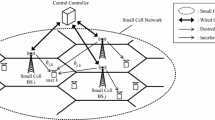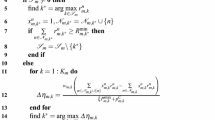Abstract
In this paper, the probability distributions of per user downlink data rate, spectral efficiency (SE) and energy efficiency (EE) are analytically derived for a heterogeneous network model with cell-edge located small cells. The high accuracies of analytically derived cumulative distribution functions (CDF) are verified using distributions obtained via simulations. CDF expressions are then used in order to optimize key performance indicators (KPI) which are selected here as 10th percentile downlink data rate (\(R_{10}\)), spectral efficiency (\(SE_{10}\)) and energy efficiency (\(EE_{10}\)). In addition to optimizing KPIs separately, we also investigate the variation of the KPIs with respect to each other employing the analytically derived distributions. The results show that the resource allocation parameter values maximizing \(R_{10}\) are very close to the values that maximize \(EE_{10}\). However, the values that are optimal for \(EE_{10}\) and \(R_{10}\) are not optimal for \(SE_{10}\), which demonstrates the EE and SE trade-off in HetNets.










Similar content being viewed by others
References
Li, Q. C., Niu, H., Papathanassiou, A. T., & Wu, G. (2014). 5G network capacity: Key elements and technologies. IEEE Vehicular Technology Magazine, 9(1), 71–78.
Chin, W. H., Fan, Z., & Haines, R. (2014). Emerging technologies and research challenges for 5G wireless networks. IEEE Wireless Communications, 21(2), 106–112.
Andrews, J. G., Buzzi, S., Choi, W., Hanly, S. V., Lozano, A., Soong, A. C. K., et al. (2014). What will 5G be? IEEE Journal on Selected Areas in Communications, 32(6), 1065–1082.
Boccardi, F., Heath, R. W., Lozano, A., Marzetta, T. L., & Popovski, P. (2014). Five disruptive technology directions for 5G. IEEE Communications Magazine, 52(2), 74–80.
Damnjanovic, A., Montojo, J., Wei, Y., Ji, T., Luo, T., Vajapeyam, M., et al. (2011). A survey on 3GPP heterogeneous networks. IEEE Wireless Communications, 18(3), 10–21.
El-atty, S. M. A., & Gharsseldien, Z. M. (2017). Performance analysis of an advanced heterogeneous mobile network architecture with multiple small cell layers. Wireless Networks, 23(4), 1169–1190.
3rd Generation Partnership Project, “Scenarios and Requirements for Small Cell Enhancements for E-UTRA and E-UTRAN,” In: 3GPP TR 36.932 V12.0.0, 2012.
Mishra, S., & Murthy, C. S. R. (2018). Efficient coverage management of pico cells in hetnets via spectrum slicing, cell biasing, and transmit power spreading. Wireless Networks, 24(8), 3099–3112. https://doi.org/10.1007/s11276-017-1525-y.
3rd Generation Partnership Project, “Summary of the Description of Candidate eICIC Solutions,” In: 3GPP R1-104968, Madrid, Spain, 2010.
Fooladivanda, D., & Rosenberg, C. (2013). Joint resource allocation and user association for heterogeneous wireless cellular networks. IEEE Transactions on Wireless Communications, 12(1), 248–257.
ElSawy, H., Sultan-Salem, A., Alouini, M. S., & Win, M. Z. (2017). Modeling and analysis of cellular networks using stochastic geometry: A tutorial. IEEE Communications Surveys and Tutorials, 19(1), 167–203.
Renzo, M. D., Guidotti, A., & Corazza, G. E. (2013). Average rate of downlink heterogeneous cellular networks over generalized fading channels: A stochastic geometry approach. IEEE Transactions on Communications, 61(7), 3050–3071.
Cheung, W. C., Quek, T. Q. S., & Kountouris, M. (2012). Throughput optimization, spectrum allocation, and access control in two-tier femtocell networks. IEEE Journal on Selected Areas in Communications, 30(3), 561–574.
Heath, R. W., Kountouris, M., & Bai, T. (2013). Modeling heterogeneous network interference using poisson point processes. IEEE Transactions on Signal Processing, 61(16), 4114–4126.
Mukherjee, S. (2012). Distribution of downlink SINR in heterogeneous cellular networks. IEEE Journal on Selected Areas in Communications, 30(3), 575–585.
Singh, S., Dhillon, H. S., & Andrews, J. G. (2013). Offloading in heterogeneous networks: Modeling, analysis, and design insights. IEEE Transactions on Wireless Communications, 12(5), 2484–2497.
Singh, S., & Andrews, J. G. (2014). Joint resource partitioning and offloading in heterogeneous cellular networks. IEEE Transactions on Wireless Communications, 13(2), 888–901.
Dhillon, H. S., Ganti, R. K., & Andrews, J. G. (2013). Load-aware modeling and analysis of heterogeneous cellular networks. IEEE Transactions on Wireless Communications, 12(4), 1666–1677.
Sambo, Y. A., Shakir, M. Z., Qaraqe, K. A., Serpedin, E., & Imran, M. A. (2014). Expanding cellular coverage via cell-edge deployment in heterogeneous networks: spectral efficiency and backhaul power consumption perspectives. IEEE Communications Magazine, 52(6), 140–149.
Guvenc, I. (2011). Capacity and fairness analysis of heterogeneous networks with range expansion and interference coordination. IEEE Communications Letters, 15(10), 1084–1087.
Jung, T., Song, I., Lee, S., Jung, S., Yoon, S., & Kang, J. (2018). Cell range expansion with geometric information of pico-cell in heterogeneous networks. In: IEEE 87th Vehicular Technology Conference (VTC Spring).
Lee, C.-N., Lin, J.-H., Wu, C.-F., Lee, M.-F., & Yeh, F.-M. (2018). A dynamic CRE and ABS scheme for enhancing network capacity in LTE-advanced heterogeneous networks, Wireless Networks. https://doi.org/10.1007/s11276-018-1723-2.
Eguizábal, M., & Hernández, A. (2013). Interference management and cell range expansion analysis for LTE picocell deployments. In: IEEE 24th Annual International Symposium on Personal, Indoor, and Mobile Radio Communications (PIMRC).
Teerasuttakorn, N., Nuanyai, K., Zamani, A., Schmeink, A., & Chantaraskul, S. (2018). Study of almost blank subframe configurations for traffic offload in hetnets. In: International Conference on Information and Communication Technology Convergence (ICTC).
Jia, Y., Zhao, M., & Zhou, W. (2016). Joint user association and eicic for max–min fairness in hetnets. IEEE Communications Letters, 20(3), 546–549.
3rd Generation Partnership Project, Further advancements for E-UTRA physical layer aspects. In: 3GPP TR 36.814 9.0.0 (2010).
Yenihayat, G., & Karaşan, E. (2018). Derivation of users’ received signal power in cell on edge configured hetnet communication system. In Technical report, Bilkent University, Ankara. http://kilyos.ee.bilkent.edu.tr/~guven/distanceDist.pdf. Accessed 5 Feb 2019.
Auer, G., Giannini, V., Desset, C., Godor, I., Skillermark, P., Olsson, M., et al. (2011). How much energy is needed to run a wireless network? IEEE Wireless Communications, 18(5), 40–49.
Panchenko, D. (2006). 18.443 statistics for applications, Massachusetts Institute of Technology: MIT OpenCourseWare. https://ocw.mit.edu/courses/mathematics/18-443-statistics-for-applications-fall-2003/lecture-notes/18443.pdf. License: Creative Commons BY-NC-SA, Fall. Accessed 17 Oct 2018.
Author information
Authors and Affiliations
Corresponding author
Additional information
Publisher's Note
Springer Nature remains neutral with regard to jurisdictional claims in published maps and institutional affiliations.
Rights and permissions
About this article
Cite this article
Yenihayat, G., Karaşan, E. Downlink data rate, energy and spectral efficiency distribution in heterogeneous networks with cell-edge located small cells. Wireless Netw 26, 2595–2608 (2020). https://doi.org/10.1007/s11276-019-02024-4
Published:
Issue Date:
DOI: https://doi.org/10.1007/s11276-019-02024-4




